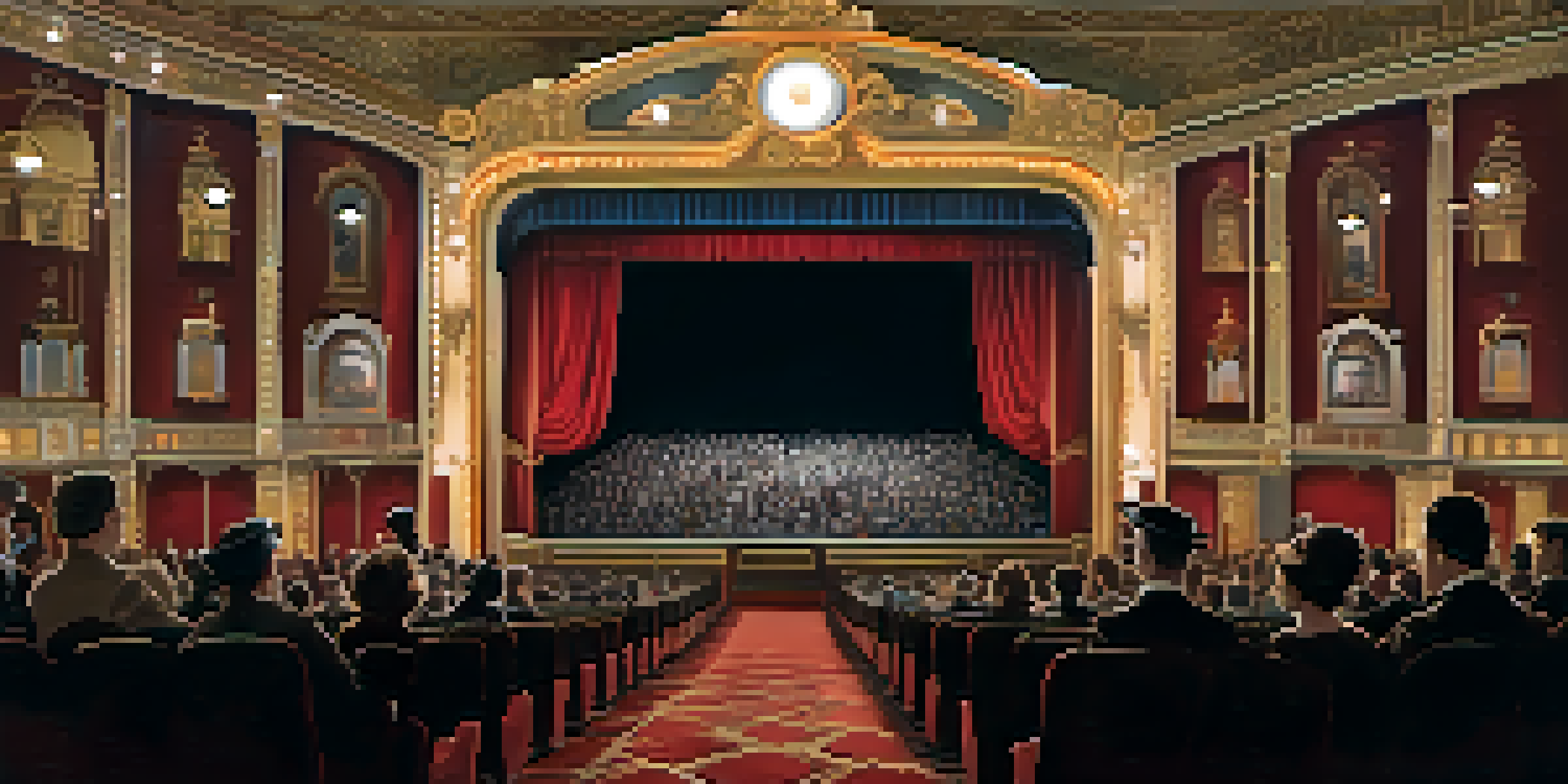The Rise of Hollywood: Birth of the Film Industry

The Birth of American Cinema in the Late 1800s
The seeds of American cinema were sown in the late 1800s, as inventors like Thomas Edison began experimenting with motion pictures. Edison's Kinetoscope, which allowed viewers to watch short films individually, paved the way for a new form of entertainment. This innovation marked a significant shift in how stories could be told, capturing the imagination of the public.
Cinema is a matter of what's in the frame and what's out.
Around the same time, the Lumière brothers in France were showcasing their Cinematographe, which projected films to larger audiences. This sparked interest across the Atlantic, and soon, American filmmakers began to experiment with longer narratives, leading to the first narrative films. As the fascination with moving images grew, so too did the desire to create more complex stories.
By 1903, the short film 'The Great Train Robbery' emerged as a landmark in storytelling, introducing techniques like editing and narrative structure. This film, often regarded as one of the first true American films, captivated audiences and demonstrated the potential of cinema as a storytelling medium.
The Move to Southern California: A New Frontier
As the film industry began to gain traction, filmmakers sought out locations that offered diverse scenery and favorable weather. This led to a migration from the East Coast to Southern California, where the sunny climate allowed for year-round shooting. Los Angeles became the epicenter of this burgeoning industry, with Hollywood emerging as its iconic neighborhood.

Hollywood's appeal wasn't just in its weather; it offered a variety of landscapes, from beaches to deserts, all within a short distance. This versatility allowed filmmakers to create different worlds without needing to travel far or build elaborate sets. The allure of the region also attracted talent, both in front of and behind the camera, eager to be part of this exciting new venture.
Cinema's Early Innovations
The late 1800s marked the birth of American cinema, driven by inventions like Edison's Kinetoscope and the Lumière brothers' Cinematographe, leading to the creation of narrative films.
By the early 1910s, Hollywood was well on its way to becoming the heart of the American film industry, with studios like Universal and Paramount establishing their roots. This shift marked the beginning of a new era, where film production became organized and professionalized, laying the groundwork for the Hollywood we know today.
The Golden Age of Silent Films: A Cultural Phenomenon
The early 1910s to the late 1920s saw the rise of silent films, a period often referred to as the Golden Age of Silent Cinema. During this time, stars like Charlie Chaplin and Buster Keaton became household names, captivating audiences with their comedic genius and physical performances. Silent films relied heavily on expressive acting and visual storytelling, making them accessible to viewers regardless of language.
The movies are a part of our lives, and we are a part of their lives.
Cinemas began popping up across America, offering affordable entertainment to the masses. With ticket prices typically lower than a meal, families flocked to theaters, creating a sense of community around film. This phenomenon not only boosted the economy but also sparked a cultural shift, as films became a primary source of entertainment.
As the industry flourished, studios began investing heavily in production values, leading to elaborate sets and costumes that enhanced storytelling. This investment paid off, as films became more sophisticated and visually striking, setting the stage for the transition to sound in the late 1920s.
The Advent of Sound: A Revolution in Filmmaking
The late 1920s marked a turning point in cinema history with the introduction of synchronized sound in films. The release of 'The Jazz Singer' in 1927, the first feature-length film with synchronized dialogue, revolutionized the industry overnight. Audiences were mesmerized, and the allure of sound quickly overshadowed the silent film era.
This transition fundamentally changed how stories were told on screen. Filmmakers had to adapt to a new style of storytelling that incorporated dialogue, music, and sound effects. Actors who had thrived in the silent era faced challenges, as some were unable to transition effectively to the new format, leading to a dramatic reshaping of Hollywood's talent pool.
Hollywood Becomes Film's Heart
The migration of filmmakers to Southern California in the early 1910s established Hollywood as the central hub of the American film industry due to its diverse landscapes and favorable climate.
The success of sound films spurred studios to invest in sound technology and training for their staff, further professionalizing the industry. By the early 1930s, nearly all films were produced with sound, marking the end of the silent film era and ushering in a new age of cinematic storytelling.
The Rise of the Studio System: Power and Control
In the 1930s and 1940s, the Hollywood studio system solidified its grip on the film industry. Major studios like MGM, Warner Bros., and 20th Century Fox controlled nearly every aspect of film production, from talent contracts to distribution. This vertical integration allowed studios to maintain high levels of output and profitability, creating a well-oiled machine.
Actors and directors became 'contract players,' often bound to studios for several years, limiting their creative freedom but ensuring steady work. This system led to the creation of iconic stars like Judy Garland and Clark Gable, who became synonymous with their respective studios. The studio system also ensured that films adhered to a specific formula, catering to audience preferences and maximizing box office returns.
However, this dominance came with its challenges, as the rigid structure sometimes stifled creativity. Filmmakers began to seek creative independence, leading to tensions within the industry. This desire for artistic freedom would eventually contribute to the decline of the studio system, setting the stage for a new era in Hollywood.
The Impact of World War II on Hollywood
World War II had a profound impact on Hollywood, both behind the scenes and on screen. The war effort saw many actors and filmmakers enlist or participate in propaganda films, uniting the industry in support of the Allied forces. This period produced films that aimed to boost morale and promote patriotism, with stars like John Wayne becoming symbols of American resilience.
As the war raged on, Hollywood also faced challenges such as labor strikes and film shortages. Many studios struggled to maintain normal production levels, leading to a shift in focus towards wartime narratives and documentaries. The industry's ability to adapt during this tumultuous time showcased its resilience and creativity.
New Hollywood's Creative Revolution
The late 1960s and 1970s saw a shift towards innovative storytelling and blockbuster films, marking the emergence of a new generation of filmmakers who challenged traditional norms.
Post-war, Hollywood experienced a boom in production as soldiers returned home and sought entertainment. The influx of new talent and fresh ideas revitalized the industry, leading to groundbreaking films that addressed social issues and reflected changing cultural attitudes. This transformation laid the groundwork for the diverse landscape of Hollywood that would unfold in the following decades.
The New Hollywood Era: Innovation and Change
The late 1960s and 1970s ushered in the New Hollywood era, characterized by a wave of innovation and a departure from traditional filmmaking conventions. Young filmmakers like Martin Scorsese and Francis Ford Coppola emerged, challenging the norms set by the studio system. Their films often tackled controversial subjects and embraced a more realistic storytelling style.
This period also saw the rise of blockbuster films, with productions like 'Jaws' and 'Star Wars' redefining box office success. These films captured the imaginations of audiences worldwide, leading to a shift in how studios approached filmmaking. The focus transitioned from artistic integrity to commercial viability, reshaping the industry's landscape.

As the New Hollywood era progressed, audiences began to crave a more diverse range of stories that reflected the complexities of American life. Filmmakers responded by pushing boundaries, addressing issues such as race, gender, and class in their narratives. This evolution not only transformed Hollywood but also set the stage for the rich tapestry of stories we see in cinema today.